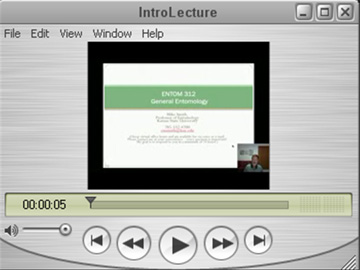General Entomology, Gene Research, Insect Stings, and International Travels: Dr. C. Michael Smith's Vision
A Q&A with Dr. C. Michael Smith, Entomology Professor and Researcher

Q: Could you share a little bit about yourself and your background in entomology? What sorts of research do you conduct?
Dr. C. Michael Smith: My interest in insects started when I was a child. In the summer, I spent a lot of time in my grandparents' flowerbeds, vegetable gardens and fruit trees, or around their stock ponds. Insects were everywhere, so I had constant exposure – dragonflies hovering along the pond, beetles on bean plants, aphids on roses. One of my favorite memories was watching tobacco hornworm moths feed on nectar of petunia flowers at dusk. It was magical! I wasn't sure if it was a moth or a hummingbird. These early memories apparently helped shape my research interests. I've been conducting research on the interactions of insects with barley, rice, soybean and wheat for over 30 years. I've been fortunate to coordinate the research of some very talented young researchers. Together, we have discovered genes in plants that control resistance to aphids, and some genes in some aphids that allow them to overcome the effects of the plant genes.
Q: How did you get started in the field of entomology? What piqued your interest?
Dr. Smith: I was a college graduate who participated in the first Earth Day, when "going green" really got started. Food shortages were severe in many parts of the world, with predictions of the need for great increases in food crop yields to feed an increasing population. I became very interested in learning more about host plant resistance, as it was then called, which incidentally was founded by Reginald Painter at Kansas State University. I wanted to understand how naturally occurring plant defenses could be purposefully bred into crop plants to increase yields and avoid the use of chemical insecticides.
Q: How would you characterize mainstream perceptions of insects?
Dr. Smith: It depends on the age of the person you ask. Children have an innate fascination with insects, and enjoy holding or touching them. Most people have fairly neutral perceptions about insects. The "entomophobia" that exist is from adults who assume that all are bad and should be killed. Of course some have had bad experiences from insect bites or stings and related adverse reactions and illnesses.
Q: How important are insects to human existence? Why?
Dr. Smith: Almost half of the food produced in the world is lost to insect feeding damage, and insects vector many diseases that kill millions of people each year. Nevertheless, without pollination of human food plants by bees, humans would have about 1/3 less food to eat.
Q: What is your vision for the Digital Entomology Lab? Please explain your inspirations.
Dr. Smith: I'd like to see students come away from the class with a good basic understanding of insect taxonomy, i.e. what makes a fly different from a beetle, and to use this knowledge to develop their own personal collection of insects. Many educators have avoided laboratory courses, but with distance/online classes available in virtually any discipline, it's time for a digital entomology laboratory course that introduces taxonomy and classification.
Q: Why is it important to understand insect morphology? What are some curious aspects of insect morphology?
Dr. Smith: Molecular markers are now common in insect taxonomy, but for the most part basic taxonomy still relies on differences in morphological structures of insects, such as the numbers of wings, legs, or mouthparts that different species possess. But morphology is as much about function as structure. For example, adhesive footpads that help flies walk on ceilings, or the modified hind wings of flies that allow them to hover like a helicopter.
Q: Please describe some of the assignments you would have students complete through the Digital Entomology Lab.
Dr. Smith: I plan for students to complete similar tasks as in an actual classroom. They will learn how to collect, mount, pin and preserve different insects, and to classify their collection based on comparisons of morphological differences.
Q: What challenges do you anticipate in taking this Digital Entomology Lab project to the next phases? What are the main hurdles? How do you plan to overcome them?
Dr. Smith: The main hurdle will be providing virtual "hands on" training, as effectively as in person, i.e., I need to develop effective videos on several topics such as proper pinning of different insects.
Q: What are your ambitions for your online "General Entomology" course that you'll be teaching for the first time this Fall Semester 2011?
Dr. Smith: My ambition is to get the course "out there" and see how it's received, as with other courses I've developed. I've probably "over functioned" in developing the General Entomology distance course – partly because of my need to gain confidence in the virtual learning environment. I'm very pleased with how course content has been revised, augmented and merged with the Screenflow software that provides students narrated videos of each topic. Shalin Hai-Jew has been an excellent mentor who has been very helpful and patient in this process.
Q: What are some practical ways that entomology knowledge and education lead to a professional career?
Dr. Smith: This relates back to the importance of insects to human existence, with pest insects responsible for destroying so much human food and vectoring so many fatal diseases. More than ever before, knowledge and education about insect behavior, ecology, physiology, molecular genetics and now genomics is being developed and used to combat these pests. In education, government, and industry, there are many useful and rewarding careers for aspiring entomologists who want to help find solutions to the problems posed by insects.
Q: You have traveled quite a bit for your work, and you have future professional trips planned. What have some of your most memorable trips been? What are some insights you've acquired from your professional travels?
Dr. Smith: My first international trip was to Japan in 1980, which was very interesting. Two years later I traveled to Liberia, where I helped teach a pest management short course. I lived with the trainees and fellow trainers in a dormitory at a rural agricultural university - a very bucolic place and a good professional experience. But a government coup was brewing, and our group was told by the U.S. consulate to leave the country earlier than planned. We did so, after paying a large and unexpected "departure tax." On that trip, I began to understand that everyone who eats is interested in insects, and that unlike governments, insects know no geographic borders.
Thank you for your time!
An Introductory Lecture
Dr. C. Michael Smith contextualizes General Entomology here for his online students. He used Screenflow(TM) on his Mac desktop computer as the lecture-capture tool for this presentation. The video then was converted to .mp4 using Any Video Converter(TM).
Directions: Click on the following video icon to see an introductory lecture used for the ENTOM 312 "General Entomology" course that will be offered later this Fall Semester 2011. You may full-screen the video to make it more readable. (To make this video more easily playable, this has been output as an .mp4, which is a smaller pod-castable video file format.)
To enhance the accessibility of the video, attached are copies of the slideshow.
Introductory Slideshow (.pptx)
NEXT: Experience "An Insect Exploratory" to help participatory designers prepare for sharing their design ideas. The first activities involve ways to explore the language in a domain field--the "terms of art." There are word search and crossword puzzle activities. (Click "next page" below, or click the proper page number above.)



